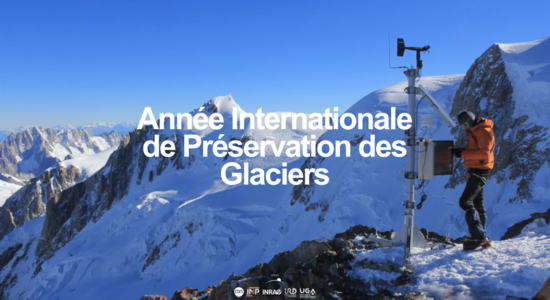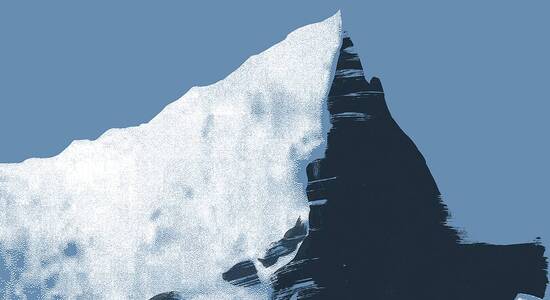Glacier monitoring in the Himalaya / La surveillance des glaciers dans l'Himalaya
Publié par Institut des Géosciences de l'Environnement IGE, le 30 juin 2021 1.7k
L'article est disponible en version française en-dessous.

In Himalayas, the regular field base glacier monitoring is always challenging for everyone. So only few glaciers were monitored in the last few decades. In Nepal Himalaya we do the regular field work for the glacier monitoring and Automatic Weather Stations (AWS) download and maintenance. From the data collected from fieldwork, we found the mass changes of Himalayan glacier are different in different areas. Even within a short distance mass changes of glaciers are different due to the topographic disturbance and variation.
In last few years what I can say is that the glaciers are losing mass very rapidly in different ways among which the loss due to wind erosion is still unknown.

Also due to the few Automatic Weather Station in the high altitude areas, the spatial variation, frequency, intensity and form (snow/rain) of precipitations is still poorly understood, despite the fact that it has enormous impacts on the glaciers health. For the estimation of mass loss, both the melt model and energy balance model seem good in the ablation area but for the accumulation area only the energy balance is found usable due the low temperature. Now there are lots of energy balance models which I am applying during my PhD. And I hope I will get the better result than previously published results.

This article was written by Arbindra Khadka, a 1st year PhD at the IGE

Dans l'Himalaya, la surveillance régulière des glaciers sur le terrain est toujours un défi pour tout le monde. Ainsi, seuls quelques glaciers ont été surveillés au cours des dernières décennies. Dans l'Himalaya népalais, nous effectuons un travail de terrain régulier pour la surveillance des glaciers, le téléchargement et la maintenance des stations météorologiques automatiques (AWS : Automatic Weather Stations). D'après les données recueillies sur le terrain, nous avons constaté que les changements de masse des glaciers de l'Himalaya sont différents selon les régions. Même sur une courte distance, les changements de masse des glaciers sont différents en raison des perturbations et des variations topographiques.
Ces dernières années, ce que je peux dire, c'est que les glaciers perdent de la masse très rapidement et de différentes manières, parmi lesquelles la perte due à l'érosion éolienne est encore inconnue.

De plus, en raison du peu de stations météorologiques automatiques dans les zones de haute altitude, la variation spatiale, la fréquence, l'intensité et la forme (neige/pluie) des précipitations sont encore mal comprises, malgré le fait qu'elles ont un impact énorme sur la santé des glaciers. Pour l'estimation de la perte de masse, le modèle de fonte et le modèle de bilan énergétique semblent bons dans la zone d'ablation, mais pour la zone d'accumulation, seul le bilan énergétique est utilisable en raison de la basse température. Il existe maintenant de nombreux modèles de bilan énergétique que j'applique pendant mon doctorat. Et j'espère que j'obtiendrai de meilleurs résultats que ceux publiés précédemment.

Cet article a été rédigé par Arbindra Khadka, doctorant en 1ère année de thèse à l'IGE.
Photo and video credits: Arbindra Khadka & Patrick Wagnon
Références
- Khadka, A., 2021, Studying glaciers during the pandemic
- Khadka, A., T. Matthews, L. B. Perry, I. Koch, P. Wagnon, D. Shrestha, et al. 2021. Weather on Mount Everest during the 2019 summer Monsoon. Weather. https://doi.org/10.1002/wea.39...
- Litt, M, J. M. Shea, P. Wagnon, J. Steiner, I. Koch, and E. Stigter.,2019. Glacier ablation and temperature indexed melt models in the Nepalese Himalaya. Scientific reports, 9(1), 1-13. https://doi.org/10.1038/s41598...
- Sherpa, S., and Coauthors, 2017. Contrasted surface mass balances of debris-free glaciers observed between the southern and the inner parts of the Everest region (2007–15). Journal of Glaciology, 63(240), 637-651. https://doi:10.1017/jog.2017.3...
- Wagnon, P., and Coauthors, 2020. Reanalysing the 2007–19 glaciological mass-balance series of Mera Glacier, Nepal, Central Himalaya, using geodetic mass balance. Journal of Glaciology, 67(261), 117-125. https://doi:10.1017/jog.2020.8...




